Complete Solutions to Exercises Single Correct of chapter AROMATIC COMPOUNDS AND ALKYL AND ARYL HALIDES of Class 12 book with complete answers and questions
| Class 12 | CHEMISTRY |
| Chapter | AROMATIC COMPOUNDS AND ALKYL AND ARYL HALIDES |
| CENGAGE CHEMISTRY | Exercises Single Correct |
| Number Of Questions | 100 |
| Academic Year | 2023-24 |
The decreaing order of the rate of niration of the following compounds is
I. Benzene, II. `C_(6)D_(6)`
III. Nitrobenzene, IV Chlorobenzene03:51View SolutionThe decreasing order of the rate of bromination of the following compounds is:
I. `PhN^(o+)Me_(3)`, II. `PhCH_(2) NMe_(3)`
III. `PhMe`, IV. `PhNMe_(2)`04:06View SolutionThe decreasing order of aromaticity fo the following is
I. Benzene, II. Napthalene, III. Anthrance03:16View SolutionIn the following reaction, which of the folliwing steps is wrong?
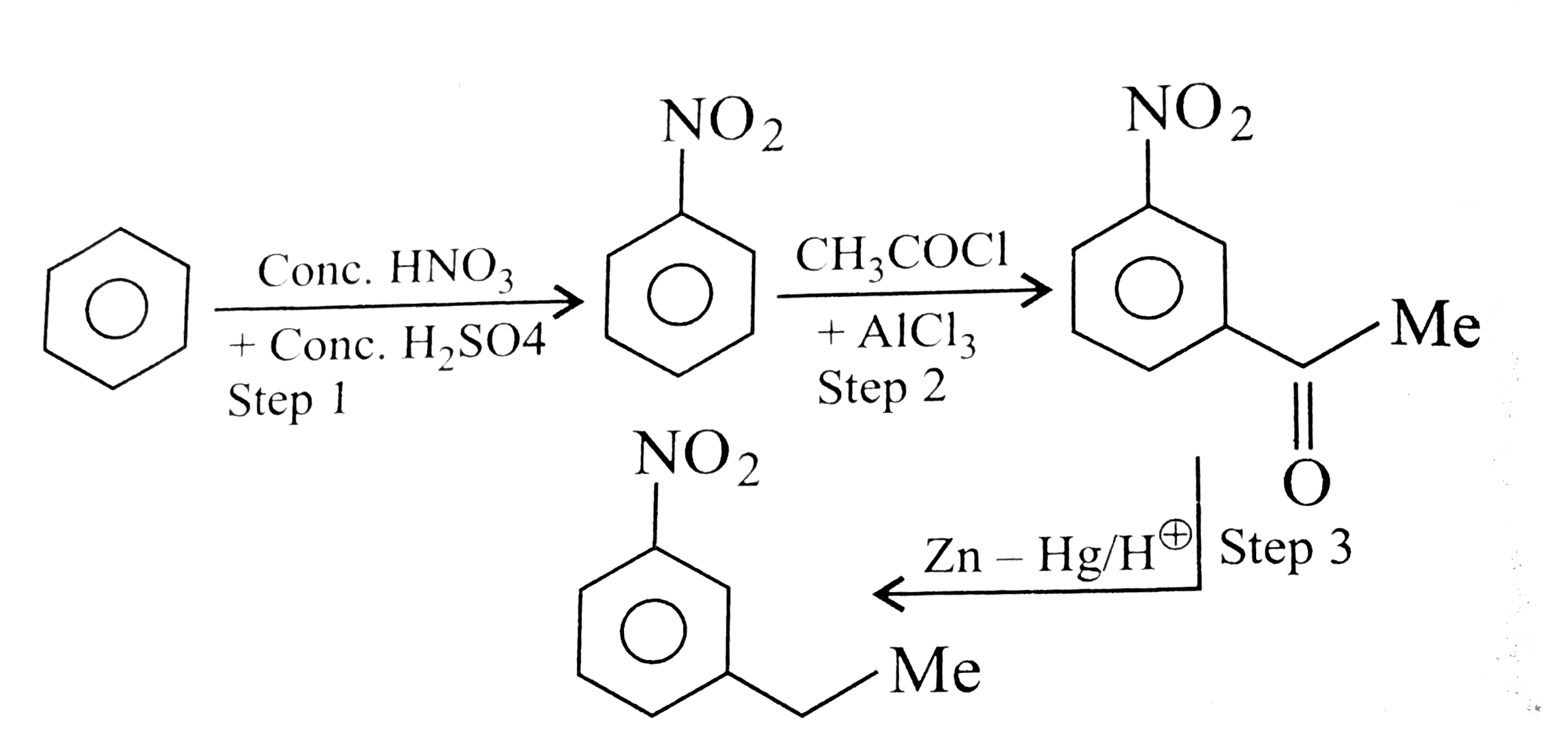 04:32View Solution
04:32View SolutionIn the following reaction, which of the folliwing steps is wrong?
 03:40View Solution
03:40View SolutionNitration of xylene gives only one mono-nitro derivaties. Which xylene is it?
01:58View SolutionThe final product `(X)` in the following reactionis: `NHCOCH_(3)`
 02:49View Solution
02:49View SolutionWhich of the following halides will be most reactive in `SN^(2)` reaction and `SN^(1)` reaction respectively?
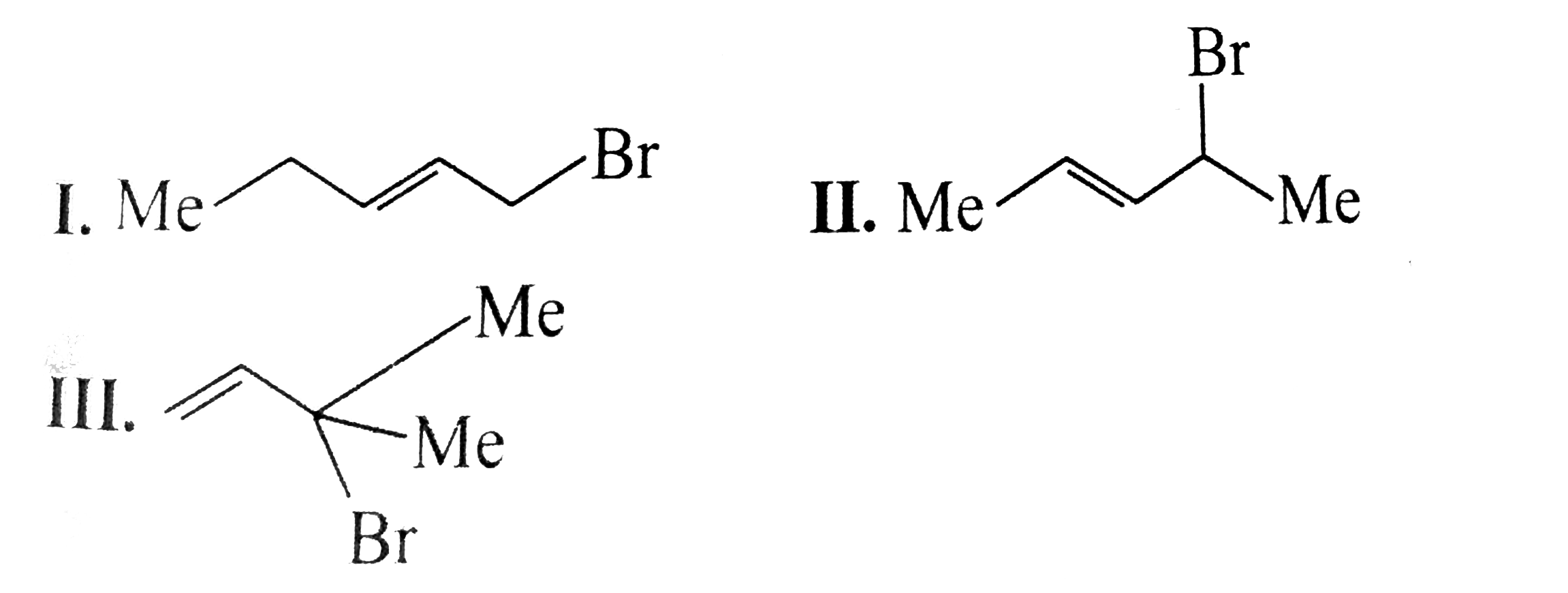 04:29View Solution
04:29View Solution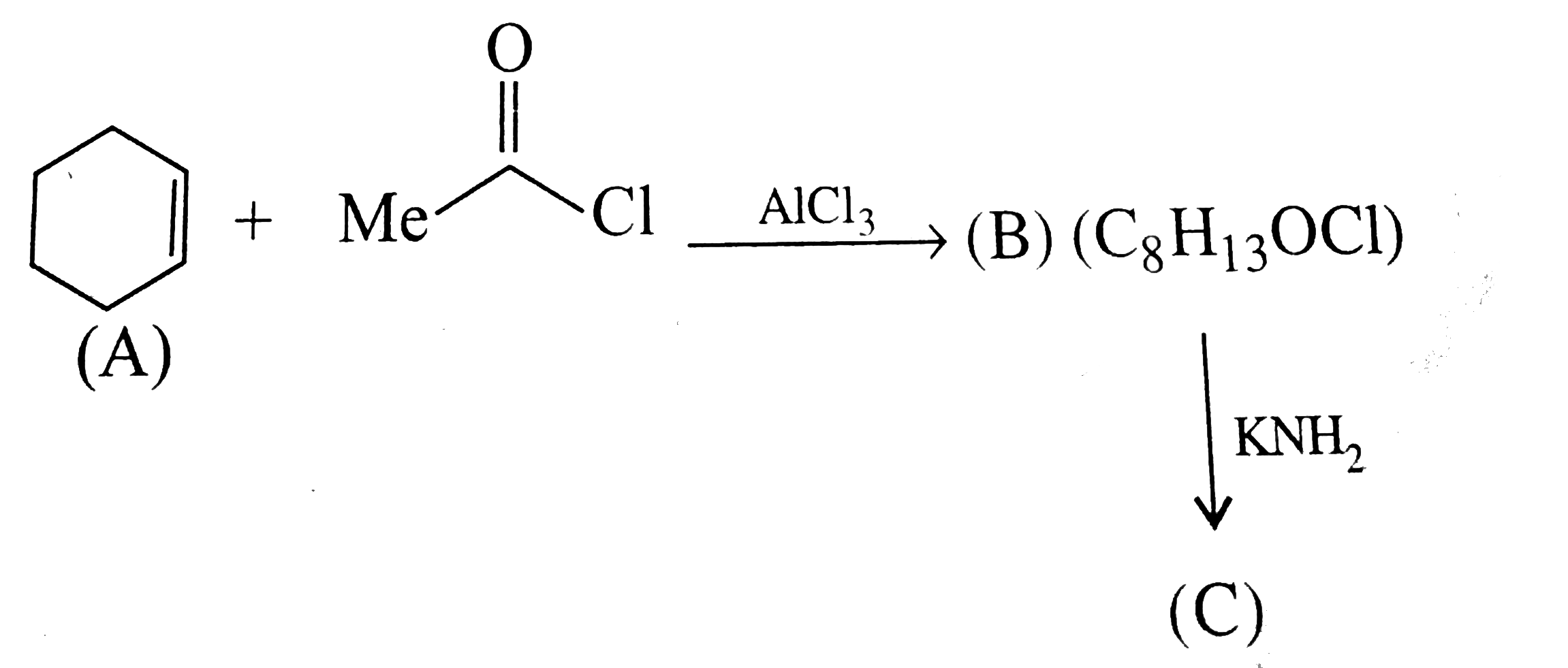
Compounds `(B)` and `(C)` respectively are:02:51View SolutionGive the major product of the folliwng reaction.
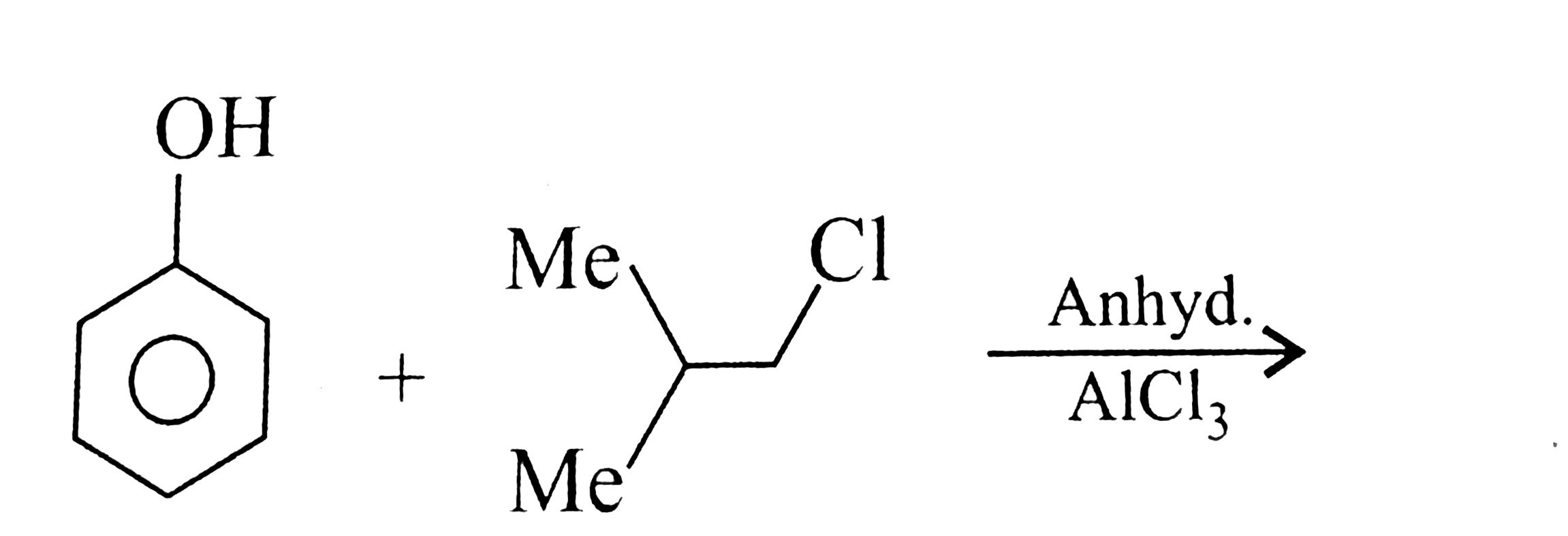 02:49View Solution
02:49View Solution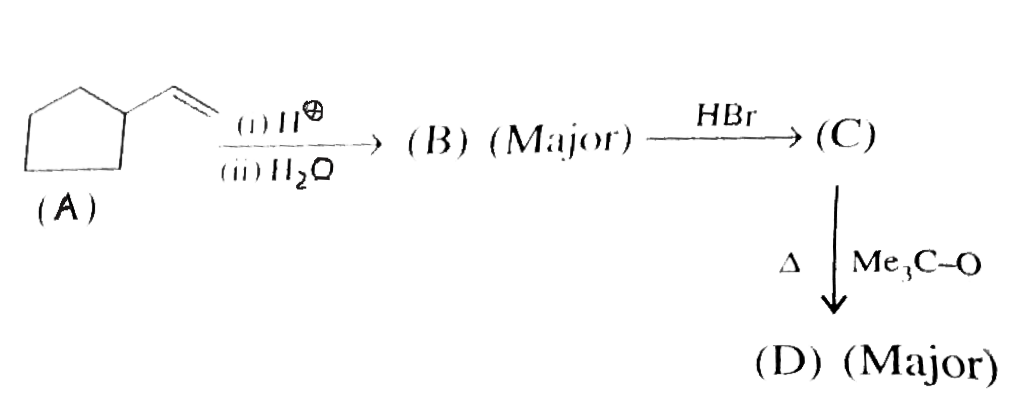
Compound `(D)` is:03:49View Solution
The above conversion can be carried out by which process.03:40View Solution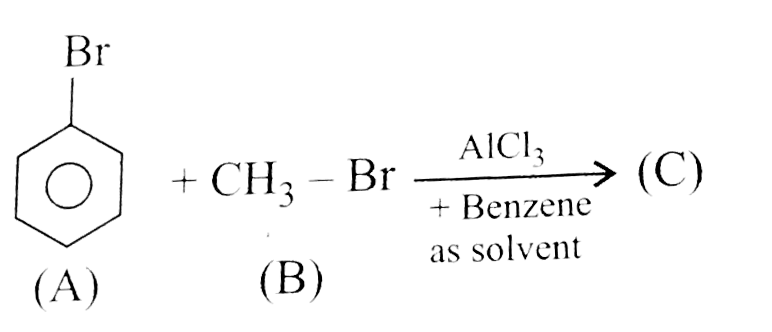
Product `(C)` is:01:50View SolutionIn the follwing reactionsL

the rate of reaction `(I)` and `(II)` are some. Both reactions proceeds by which mechanism.04:46View SolutionIn which case will `SE` not be in `m-` position?
03:31View SolutionWhich of the folliwng has the highest dipole moment?
03:42View SolutionWhich of the following is the most stable carbonium or benzenium ion?
03:16View SolutionWhich of the following ketonic compound is the least stable?
03:54View SolutionWhich of the following compounds will give curdy precipate with `AgNO_(3)` solution?
04:42View SolutionWhich of the folliwng compounds is the most reactive towards electrophilic substitution reaction?
03:44View SolutionWhich of the folliwng is the most stable species?
03:31View SolutionWhich of the following in not aromatic in nature?
03:00View SolutionWhich of the following species will be least stable?
03:01View SolutionWhich of the follwing compounds will undergo Friedel Creadfts alylation with faster rate?
04:14View SolutionWhich of the following is anti-aromatic in nature?
03:20View SolutionWhich of the following aromatic compounds is least reactive towards electrophilic substituions?
View SolutionWhich of the folliwng compounds will show faster `ArSN^(2)` reactions?
03:01View SolutionWhich of the folliwng is the order of the rate of reaction of `C_(6)H_(6),C_(6)D_(6)`, and `C_(6)T_(6)` towards sulphonation?
02:51View SolutionWhich of the folliwng is the correct order of the order of the rate of reaction of `C_(6)H_(6), C_(6)D_(6)` and `C_(6) T_(6)` towards nitration?
02:47View SolutionWhich of the following will give `SN^(2)` mechanism?
02:57View SolutionWhich of the following compounds gives `SN^(1), SN^(2)` and `SN^(2)` mechanisms?
05:21View SolutionWhich of the folliwning ether wil always give `SN^(2)` mechanism in acidic as well as basic conditions?
03:19View SolutionWhich of the follwoign ether will always give `SN^(2)` mechanism in acidic as well as basic conditions?
View SolutionWhich of the following substrates will gave racemised product?
02:45View SolutionThe energy of activation is lowest for which reaction?
02:28View SolutionIsopentane on monochlorination gives....isomers and out of them ....... Are optically active.
03:15View SolutionPropane on dichlorinatin gives......isomers and out of them .....are optically active.
02:48View SolutionA solution of (+)2-chloro-2-phenylethane in toluene racemises slowly in the presence of small amount of `SbCl_(5)` due to the formation of-
03:48View SolutionThe number of isomers for the compounds with molecular formula `C_(2)BrClFI` is:
02:20View SolutionThe decreasing basic order of the following compounds is:
i. `NH_(3)`, ii. `PH_(3)`, iii. `AsH_(3)`, iv. `SbH_(3)`02:12View SolutionThe decreasing nucleophilic order of the following compounds is:
i. `NH_(3)`, ii. `PH_(3)`, iii. `AsH_(3)`, iv. `SbH_(3)`03:59View SolutionThe decreasing nucleophilic order of the following compounds is:
i. `NH_(3)`, ii. `PH_(3)`, iii. `AsH_(3)`, iv. `SbH_(3)`03:59View SolutionThe decreasing basic order of the following is:
i. `F^(o-)`, ii. `Cl^(o-)`, iii. `Br^(o-)`, Iv. `I^(o-)`03:08View SolutionThe decreasing nucleophillic order fo the following compounds is:
i. `F^(o-)`, ii. `Cl^(o-)`, iii. `Br^(o-)`, Iv. `I^(o-)`03:37View SolutionThe decreasing leaving group order of the following is:
i. `F^(o-)`, ii. `Cl^(o-)`, iii. `Br^(o-)`, Iv. `I^(o-)`03:23View SolutionThe decreasing basic order of the following is:
i. `overset(o-)(C)H_(3)`, ii. `overset(o-)(N)H_(2)`, iii. `overset(o-)(O)H`, iv. `F^(o-)`03:01View SolutionThe decreasing nucleophilic oder of the following compounds is:
i. `overset(o-)(C)H_(3)`, ii. `overset(o-)(N)H_(2)`, iii. `overset(o-)(O)H`, iv. `F^(o-)`02:27View SolutionThe deecreasing leaving group order of the following compounds is:
i. `overset(o-)(C)H_(3)`, ii. `overset(o-)(N)H_(2)`, iii. `overset(o-)(O)H`, iv. `F^(o-)`03:58View SolutionThe decarising basic order of the following is:
i. `F_(3)CSO_(3)^(o-)`, ii. `Cl_(3)C-COO^(o-)`
iii. `PhSO_(3)^(o-)`, iv. `MeSO_(3)^(o-)`04:28View SolutionThe decresing nuclephilic order of the following is:
i. `F_(3)CSO_(3)^(o-)`, ii. `Cl_(3)C-COO^(o-)`
iii. `PhSO_(3)^(o-)`, iv. `MeSO_(3)^(o-)`04:57View SolutionThe decreasing leaving group order of the following is:
i. `F_(3)CSO_(3)^(o-)`, ii. `Cl_(3)C-COO^(o-)`
iii. `PhSO_(3)^(o-)`, iv. `MeSO_(3)^(o-)`04:28View SolutionThe decreasing basic order of the following compounds is:
i. `H_(2)O`, ii. `H_(2)S`, iii. `H_(2)Se`, iv. `H_(2)Te`02:28View SolutionThe decasing nucleophilic order of the following compounds is:
i. `H_(2)O`, ii. `H_(2)S`, iii. `H_(2)Se`, iv. `H_(2)Te`04:08View SolutionThe decreasing leaving group order (fugacity order) of the following compounds is:
i. `H_(2)O`, ii. `H_(2)S`, iii. `H_(2)Se`, iv. `H_(2)Te`03:07View SolutionThe decreasing basic order of the following is:
i. `overset(o-)(C)H_(3)`, ii.` overset(o-)(O)H`, iii. `CH_(3)COO^(o-)`, iv. `H_(2)O`02:40View SolutionThe decreasing nucelophilic order of the following compounds is:
i. `overset(o-)(C)H_(3)`, ii.` overset(o-)(O)H`, iii. `CH_(3)COO^(o-)`, iv. `H_(2)O`03:29View SolutionThe decrasing fugacity order of the following compounds is:
i.` overset(o-)(C)H_(3)`, ii.` overset(o-)(O)H`, iii. `CH_(3)COO^(o-)`, iv. `H_(2)O`03:27View SolutionThe decreasing basic order of the following is:
i. `PhSO_(3)^(o-)`, ii. `C_(2)H_(5)SO_(3)^(o-)`, iii. `C_(2)H_(5)COO^(o-)`, iv. `overset(o-)(C)N`, v. `overset(o-)(O)H`03:16View SolutionThe decreasing nucleophilic order of the following compounds is:
i. `PhSO_(3)^(o-)`, ii. `C_(2)H_(5)SO_(3)^(o-)`, iii. `C_(2)H_(5)COO^(o-)`, iv. `overset(o-)(C)N`, v. `overset(o-)(O)H`05:23View SolutionThe decreasing fugacity order of the following compounds is:
i. `PhSO_(3)^(o-)`, ii. `C_(2)H_(5)SO_(3)^(o-)`, iii. `C_(2)H_(5)COO^(o-)`, iv. `overset(o-)(C)N`, v. `overset(o-)(O)H`05:21View SolutionThe decreaing basic order of the following is:
i. `overset(o-)(C)N`, ii. `overset(o-)(O)H`, iii. `overset(o-)(O) Me`, iv. `overset(o-)(C)H_(3)`, v. `H^(o-)`02:01View SolutionThe decreasing nucelophilc order of the following compounds is:
i. `overset(o-)(C)N`, ii. `overset(o-)(O)H`, iii. `overset(o-)(O) Me`, iv. `overset(o-)(C)H_(3)`, v. `H^(o-)`View SolutionThe decreasing fugacity order of the following is:
i. `overset(o-)(C)N`, ii. `overset(o-)(O)H`, iii. `overset(o-)(O) Me`, iv. `overset(o-)(C)H_(3)`, v. `H^(o-)`04:28View SolutionThe decrasing basic order of the following is:
i. `Me_(2)N - NMe_(2)`, ii. `MeNH-NHMe`
iii. `H_(2)N - NH_(2)`, iv. `NH_(3)`02:39View SolutionDecreasing nucelophilic order of the following is:
i. `Me_(2)N - Nme_(2)`, ii. `MeNH-NHMe`
iii. `H_(2)N - NH_(2)`, iv. `NH_(3)`03:10View SolutionThe decresing fugacity order of the following is:
i. `Me_(2)N - Nme_(2)`, ii. `MeNH-NHMe`
iii. `H_(2)N - NH_(2)`, iv. `NH_(3)`03:50View Solution`underset("Specific rotation" = +50^(@))(Ph-CH(OH)CH_(3)) overset(SOCl_(2))(rarr) underset(Cl)underset(|)(PhCH) - CH_(3)`
What si the specific rotation of the product?02:12View Solution`underset("Specific rotation" = +50^(@))(Ph-CH(OH)CH_(3)) overset(SOCl_(2))(rarr) underset(Cl)underset(|)(PhCH) - CH_(3)`
Which of the following acts as a nucelphilic?02:37View Solution`underset("Specific rotation" = +50^(@))(Ph-CH(OH)CH_(3)) overset(SOCl_(2))(rarr) underset(Cl)underset(|)(PhCH) - CH_(3)`
The reaction is carried out in the presence of pyridne, Which of the following mechanisms does it follow?02:22View Solution`underset("Specific rotation" = +50^(@))(Ph-CH(OH)CH_(3)) overset(SOCl_(2))(rarr) underset(Cl)underset(|)(PhCH) - CH_(3)`
Which of the following acts as a leaving group?02:52View Solution`CH_(3) - CH(Cl) - C_(2)H_(5) overset(Alc.KOH)(rarr) CH_(3) - CH = CH - CH_(3)`
The above reaction proceeds via `ElcB` mechanism. Which of the followiing statements is true about `ElcB` mechanism?03:16View SolutionAlkyl halides can be obtained by all methods except
03:40View SolutionNeopentyl chloride on reaction with ethanolic KOH is likely to give
02:24View SolutionIn the reaction
`CH_(3)C equiv C^(-)Na^(+) + (CH_(3))_(2) `CHCl `rarr` Product the product fomed is :03:30View SolutionIn order to get ethanethiol from bromoethane, the reagent used is :
02:05View SolutionFor the preparation of chloroethane,
03:11View SolutionX on treatment with sodium hydroxide followed by the addition of silver nitrate give white precipitate at room temperature which are soluble in `NH_(4)OH`. X can be :
03:34View SolutionWhich of the following cannot be used for the preaparation of iodofrom ?
03:07View SolutionWhich of the following hladies is capable of exhibitin enantiomerism?
04:22View SolutionA suspension of `CaOCl_(2)` in water is heated with ethanol, the product formed is :
02:15View SolutionPick up the correct statements about alkyl halides.
04:18View SolutionWhich of the following is a geminal dihalide ?
02:50View Solution`C_(2)H_(5)I overset(AgNO_(2))rarr underset(("major product"))("X. Here X")` is :
02:09View SolutionWhich of the following sequence would yield m-nitrochlorobenzene (Z) from benzene ?
03:02View Solution`C_(3)H_(7) Cl overset(KOH(alc.))(rarr) (A) underset(770K)overset(Cl_(2) (g))(rarr) (X).(X)` can be:
View SolutionWhich of the following alkyl halides undergoes the fastest `S_(N^(1))` reaction ?
04:05View SolutionChoose the incorrect reaction.
View SolutionIn order to convert aniline into chlorobenzene the reagents needed are
02:21View SolutionThe reaction between chloral and chlorobenzene in `H_(2)SO_(4)` yields:
04:05View SolutionUnder the influene of air and light chloroform decomposes into
02:14View SolutionWhen iofoform is heated with silver poweder, the gaseous product formed is:
View SolutionThe reaction involving the treatment of benzene diazonium chloride with copper powder and HCl is treated as
04:10View Solution`C_(6)H_(5)Cl underset("625 K 300 atm")overset(NaOH(aq.))(rarr)...` The product can be:
View Solution`(CH_(3))_(2)CHI overset(KOH)underset(EtOH)rarr A overset(SO_(2)Cl_(2))underset(475 K)rarr B`
The compound B in the sequence is02:05View SolutionIn given sequence of reaction predict X
`X overset(KOH)underset(H_(2)O)rarr Y overset(Al_(2)O_(3))underset(633 K)rarr Z overset([O])rarr2` moles of `CH_(3)COOH`02:59View SolutionIodofrom can be prepared from:
03:32View SolutionWhen bromoethane is treated with potassium sulphide, the main product formed is
01:26View Solution`(CH_(3))_(2)"CHCl + Nal" rarr (CH_(3))_(2)"CHl+ NaCl"`
The above reaction is known as:02:57View SolutionIsopropyl alcohol is heated with a suspension of bleaching powder `(CaOCl_(2))` with water. The products are :
04:03View SolutionOut of monochloro, monobromo and monoiodo derivatives of ethane, the least reactive compound towards nucleophilic substitutions will be :
03:25View Solution
Exercises Single Correct questions and complete solutions for chapter AROMATIC COMPOUNDS AND ALKYL AND ARYL HALIDES of CENGAGE CHEMISTRY (ENGLISH) of Class 12
All Exercises from CENGAGE CHEMISTRY Class 12 CHEMISTRY AROMATIC COMPOUNDS AND ALKYL AND ARYL HALIDES
- Archives Assertion-Resoning
- Archives Fill In Theblanks
- Archives Mutiple Correct
- Archives Mutiple Correct Answers Type
- Archives Single Correct
- Archives Single Correct Answer Type
- Archives Subjective
- Archives Subjective Type
- Exercises Assertion-Resoning
- Exercises Assertion-Resoning Type
- Exercises Concept Application
- Exercises Concept Application Type
- Exercises Linked Compreshension
- Exercises Linked Compreshension Type
- Exercises Multiple Correct
- Exercises Multiple Correct Answers Type
- Exercises Single Correct
- Exercises Single Correct Answer Type
- Exercises Subjective
- Exercises Subjective Type
- Illustration
- Solved Examples
- Solved Problems
